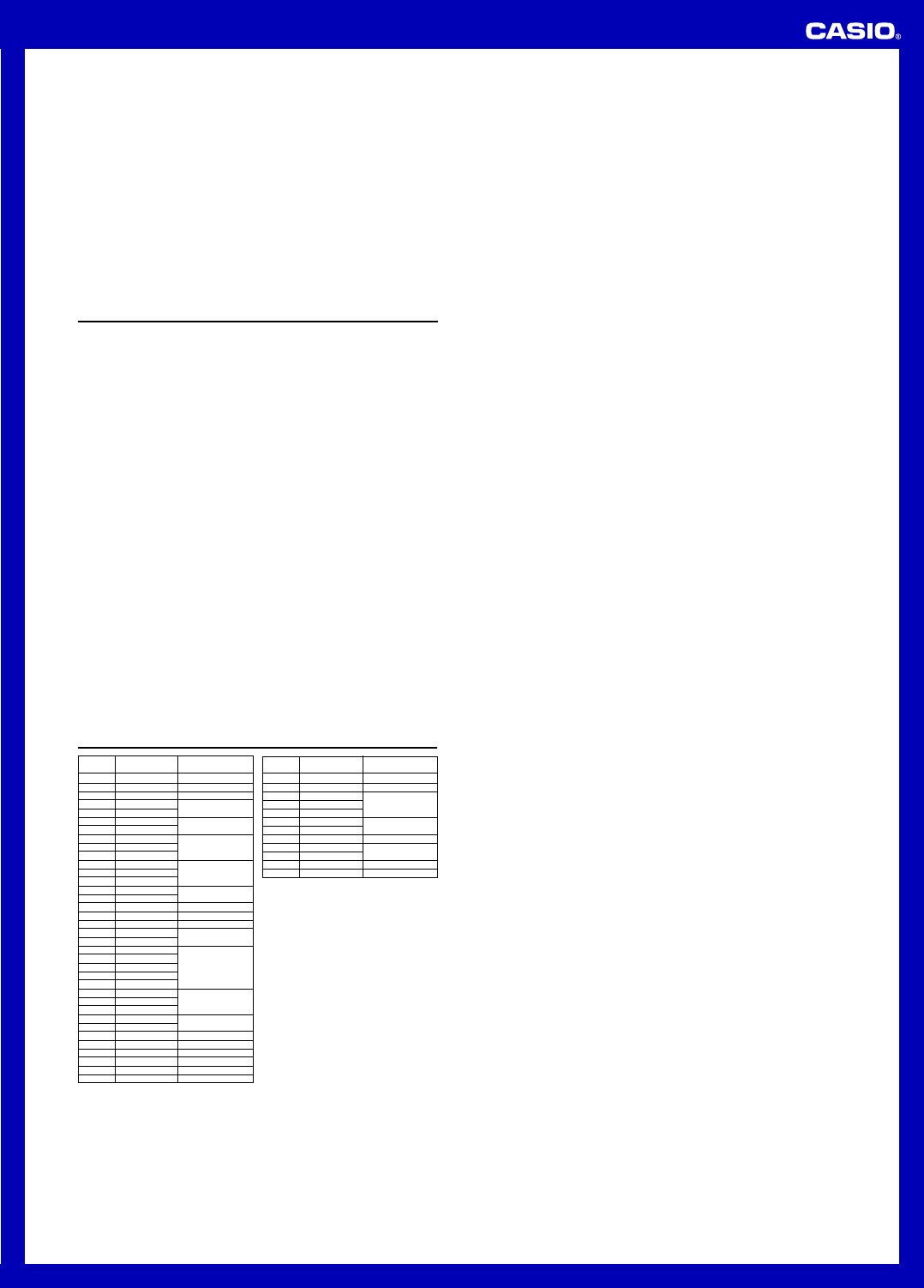
Operation Guide 3107
6
12-hour/24-hour Timekeeping Formats
The 12-hour/24-hour timekeeping format you select in the Timekeeping Mode is also
applied in all other modes.
• With the 12-hour format, the PM indicator (P) appears on the display for times in the
range of noon to 11:59 p.m. and no indicator appears for times in the range of
midnight to 11:59 a.m.
• With the 24-hour format, times are displayed in the range of 0:00 to 23:59, without
any indicator.
Illumination Precautions
• The electro-luminescent panel that provides illumination loses power after very long
use.
• Illumination may be hard to see when viewed under direct sunlight.
• The watch may emit an audible sound whenever the display is illuminated. This is
due to vibration of the EL panel used for illumination, and does not indicate
malfunction.
• Illumination turns off automatically whenever an alarm sounds.
• Frequent use of illumination runs down the battery.
Specifications
Accuracy at normal temperature: ± 30 seconds a month (with no signal calibration)
Timekeeping: Hour, minutes, seconds, p.m. (P), month, day, day of the week
Time system: Switchable between 12-hour and 24-hour formats
Calendar system: Full Auto calendar pre-programmed from the year 2000 to 2099
Other: Home city code (can be assigned one of 48 city codes); Daylight
Saving Time (summer time)/Standard Time
Time Calibration Signal Reception: Auto receive up to six times a day (remaining
auto receives cancelled as soon as one is successful); Manual Receive;
Last Signal screen
Receivable Time Calibration Signals: Mainflingen, Germany (Call Sign: DCF77,
Frequency: 77.5 kHz); Anthorn, England (Call Sign: MSF, Frequency: 60.0
kHz); Fort Collins, Colorado, the United States (Call Sign: WWVB,
Frequency: 60.0 kHz); Fukushima, Japan (Call Sign: JJY, Frequency: 40.0
kHz); Fukuoka/Saga, Japan (Call Sign: JJY, Frequency: 60.0 kHz)
World Time: 48 cities (29 time zones)
Other: Standard Time/Daylight Saving Time (summer time)
Stopwatch
Measuring unit: 1/100 second
Measuring capacity: 999:59' 59.99''
Measuring modes: Elapsed time, split time, two finishes
Other: Auto-Start
Countdown Timer
Measuring unit: 1/10 second
Input range: 1 to 60 minutes (1-minute increments)
Alarms: 5 daily alarms (Four one-time alarms; one snooze/one-time alarm); Hourly
Time Signal
Illumination: EL (electronic-luminescent panel)
Other: Battery power indicator; Power Saving; Button operation tone on/off
Power Supply: Solar cell and a rechargeable battery
Approximate Battery Operating Time
9 months (from full charge to Level 4 when the watch is not exposed to light)
under the following conditions:
• Display on 18 hours per day, sleep state 6 hours per day
• 1 illumination operation (1.5 seconds) per day
• 10 seconds of alarm operation per day
• 10 minutes of signal reception per day
Frequent use of illumination can shorten battery operating time.
City Code Table
Pago Pago
Honolulu
Anchorage
Vancouver
Los Angeles
Edmonton
Denver
Mexico City
Winnipeg
Chicago
Miami
Toronto
New York
Caracas
Halifax
St. Johns
Rio De Janeiro
Praia
Lisbon
London
Madrid
Paris
Rome
Berlin
Stockholm
Athens
Cairo
Jerusalem
Moscow
Jeddah
Tehran
Dubai
Kabul
Karachi
Delhi
Dhaka
City
City
UTC Offset/
Code GMT
Differential
PPG
HNL
ANC
YVR
LAX
YEA
DEN
MEX
YWG
CHI
MIA
YTO
NYC
CCS*
YHZ
YYT
RIO
RAI
LIS
LON
MAD
PA R
ROM
BER
STO
AT H
CAI
JRS
MOW
JED
THR
DXB
KBL
KHI
DEL
DAC
–11
–10
–9
–8
–7
–6
–5
–4
–3.5
–3
–1
0
+1
+2
+3
+3.5
+4
+4.5
+5
+5.5
+6
• Based on data as of June 2008.
• The rules governing global times (UTC
offset and GMT differential) and summer
time are determined by each individual
country.
* In December 2007, Venezuela changed
its offset from –4 to –4.5. Note, however,
that this watch displays an offset of –4
(the old offset) for the CCS (Caracas,
Venezuela) city code.
Yangon
Bangkok
Hong Kong
Beijing
Taipei
Seoul
Tokyo
Adelaide
Guam
Sydney
Noumea
Wellington
+6.5
+7
+8
+9
+9.5
+10
+11
+12
RGN
BKK
HKG
BJS
TPE
SEL
TYO
ADL
GUM
SYD
NOU
WLG
City
City
UTC Offset/
Code GMT
Differential








